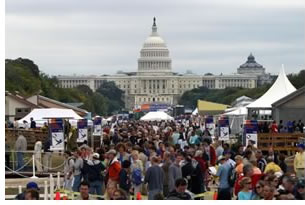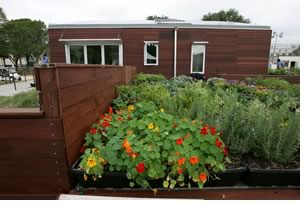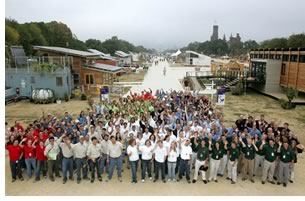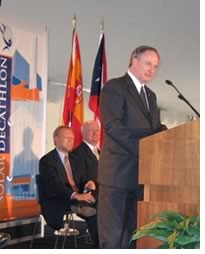

10/2005
. . . To capture the enthusiasm and energy of this year’s Solar Decathlon
 On
the National Mall in Washington, D.C., 18 college and university teams
from 13 states, Puerto Rico, Canada, and Spain built individual houses
that create a “solar village” highlighting various sustainable
design techniques and tools promoting energy efficiency, plus renewable
energy exhibits. The village will be open to the public till October
16.
On
the National Mall in Washington, D.C., 18 college and university teams
from 13 states, Puerto Rico, Canada, and Spain built individual houses
that create a “solar village” highlighting various sustainable
design techniques and tools promoting energy efficiency, plus renewable
energy exhibits. The village will be open to the public till October
16.
The contest, made especially timely by current fuel price jumps, has students competing to “design, build, and operate the most attractive, effective, and energy-efficient solar powered house.”
Like its ancient Greek namesake, this decathlon sponsors competition in 10 parts:
Architecture requires the teams to build houses that perform well technically and are attractive and well-integrated in solar and energy-efficient technologies.
 Dwelling judges whether the houses are designed well for everyday
living, simple to maintain, and attractive to potential home buyers.
They also evaluate flexibility of design and construction, the construction
methods used, and marketability of the houses.
Dwelling judges whether the houses are designed well for everyday
living, simple to maintain, and attractive to potential home buyers.
They also evaluate flexibility of design and construction, the construction
methods used, and marketability of the houses.
Documentation awards points based on how well teams analyze their designs for energy performance and how thoroughly they document the design process. Engineers evaluate the building energy analyses, and a panel of architects specializing in project management and documentation evaluates the teams’ final “as-built” drawings.
Communications challenges teams to communicate their experiences to a wide audience through Web sites and public tours.
Comfort Zone judges whether the houses maintain a steady, uniform, comfortable temperature and humidity throughout. Full points for this contest are awarded for maintaining narrow temperature (72–76°F) and relative humidity (40–55%) ranges inside the houses.
 Appliances requires that students
maintain certain temperature ranges in their refrigerators (34–40°F)
and freezers (-20–5°F).
During the competition. They must wash and dry 12 towels for two days,
cook and serve meals to contest officials for four days, clean dishes
using a dishwasher for four days, and operate a TV/video player for up
to six hours and a computer for up to eight hours for five days. Points
are awarded for this contest through measurements and task completion.
Appliances requires that students
maintain certain temperature ranges in their refrigerators (34–40°F)
and freezers (-20–5°F).
During the competition. They must wash and dry 12 towels for two days,
cook and serve meals to contest officials for four days, clean dishes
using a dishwasher for four days, and operate a TV/video player for up
to six hours and a computer for up to eight hours for five days. Points
are awarded for this contest through measurements and task completion.
Hot Water encompasses the “shower tests.” They aim to deliver 15 gallons of hot water (110°F) in 10 minutes or less. A panel of engineering judges also tours each home to make a comprehensive assessment of the hot water systems and awards points based on those assessments.
Lighting measures whether the houses meet lighting-level requirements in each room.
Energy Balance requires teams to use only the energy generated by their PV systems to provide all of the electricity for the contests. Teams earn full points if the energy supplied to the batteries is at least as much as the energy removed from the batteries.
Getting Around has student teams using electricity generated by their solar electric systems on their houses to charge their street-legal, commercially available electric vehicles. Points are awarded based on how many miles each team completes.
 The overall winner will be announced October 14.
The overall winner will be announced October 14.
A priority for DOE and AIA
U.S. Department of Energy Secretary Samuel W. Bodman opened the competition
with a message of inspiration. Referring to President Bush’s
remarks September 26 that all heads of federal agencies should concentrate
on conservation of energy, Bodman praised the Solar Decathlon goal
to design, build, and operate energy-efficient and livable homes complete
with all modern conveniences and measured in everyday living conditions. “These
are marvels of creativity and design and models of efficiency,” he
said of the homes newly opened on the Mall.
Bodman also emphasized the expanded vision for the houses the students devise. The University of Maryland will donate its home to a community providing jobs to adults with developmental disabilities. The University of Massachusetts Dartmouth will give its house to Habitat for Humanity in Louisiana. And the University of Colorado plans to donate its house to a community in Longmont, Colo.
The purpose of the competition, developed by the DOE Office of Energy Efficiency and Renewable Energy, is to encourage careers in science, including architecture and engineering, and improving the ways of using solar technology, Bodman said. The competition, which began in 2002 and was to be held every three years, will henceforth be a biennial event, with federal financial support for participating teams raised from $5,000 per team to $100,000 per team, Bodman announced. Teams also raise funds from Solar Decathlon sponsors and other private sources to design, publicize, build, and compete. Rules dictate that houses be single-story, with optional lofts, and of about 800 square feet.
 AIA Executive Vice President/CEO Norman L. Koonce, FAIA, led off the
event-sponsors’ remarks by reminding attendees that the event’s
venue, situated on “America’s Main Street,” the National
Mall, between the institutions of science and the arts—the Smithsonian
and the National Gallery of Art—is a fitting place for an event
that showcases energy-efficient and livable homes powered by the sun.
It is ironic, he said, that the same source of energy that powers these
homes is the source of energy that took so much in the hurricanes that
devastated the Gulf region.
AIA Executive Vice President/CEO Norman L. Koonce, FAIA, led off the
event-sponsors’ remarks by reminding attendees that the event’s
venue, situated on “America’s Main Street,” the National
Mall, between the institutions of science and the arts—the Smithsonian
and the National Gallery of Art—is a fitting place for an event
that showcases energy-efficient and livable homes powered by the sun.
It is ironic, he said, that the same source of energy that powers these
homes is the source of energy that took so much in the hurricanes that
devastated the Gulf region.
“The interdisciplinary teamwork that has created these houses—architecture, engineering, business, and communication students guided by their advisors—offers hope,” Koonce said. “The Solar Decathlon opens our imaginations to a wide range of ideas that are inspirational, creative, practical, and capable—as we can see—of producing great beauty. These projects are illuminated by ideas that speak as much to protecting our environment as they do to national security and our economy.”
Ongoing effort: Investment in the future
This year’s Solar Decathlon is the second competition; the
inaugural event was held in 2002. The U.S. Department of Energy’s (DOE) Office
of Energy Efficiency and Renewable Energy, DOE’s National Renewable Energy
Laboratory, serves as the sponsor and event organizer. Joining the AIA
as sponsors are the National Association of Homebuilders, BP, the DIY
Network, and Sprint.
Copyright 2005 The American Institute of Architects.
All rights reserved. Home Page ![]()
![]()
 |
||
Full
text of the opening-ceremony remarks of Norman L. Koonce, FAIA. DOE sponsors a Web site with daily updates of the Solar Decathlon, including current scores on the contests. Check it out! DOE issued its request for proposals for the 2007 Solar Decathlon on October 6. The 2005 teams: Did you know . . .
|
||